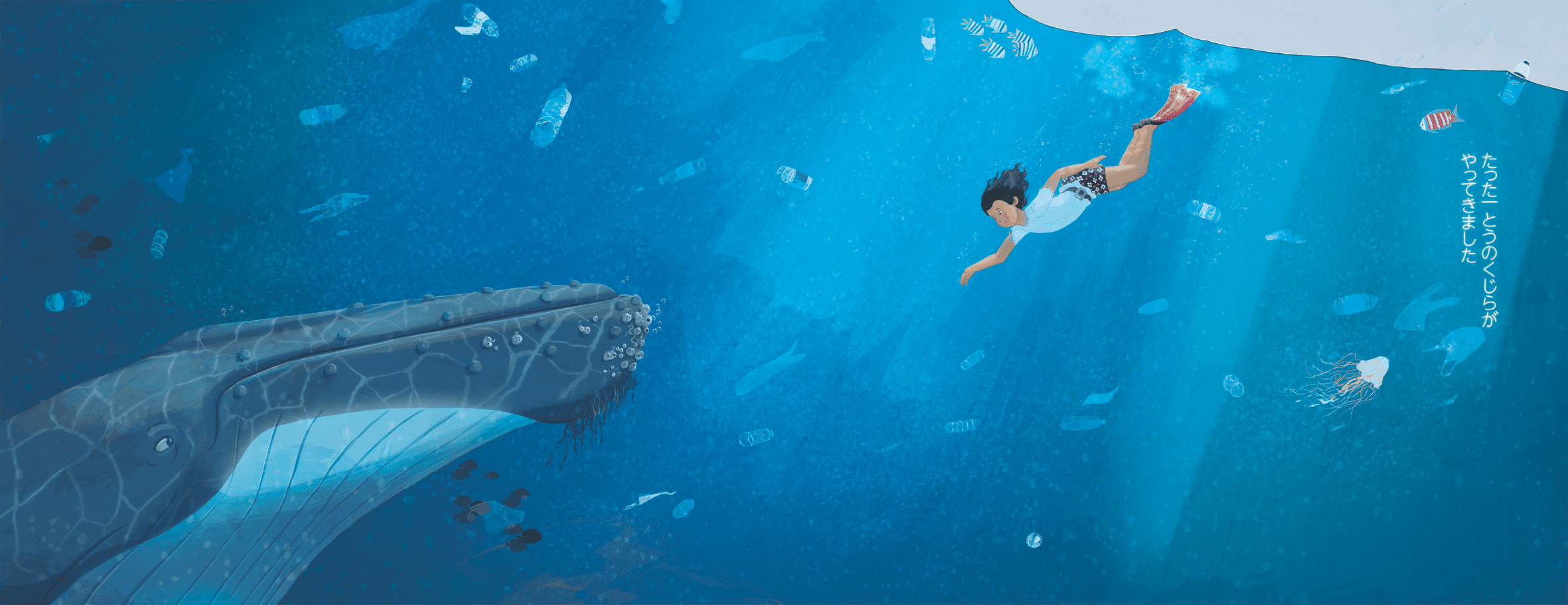
Howard Gray is the illustrator of Setsuko and the Song of the Sea, but did you know that he spent 10 years studying whales and dolphins in the wild? Well, Fiona Barker did! Having met Howard and created Danny and the Dream Dog together, Fiona wrote a brand new book all about whales, our oceans, and the importance of keeping them clean and safe. This undersea adventure became Setsuko and the Song of the Sea — a book specifically for Howard to illustrate. How amazing is that?! With that in mind, we wanted Howard to share some whale facts and tell us more about the wonderful creatures that he has spent so much time studying.
Take it away, Howard!
Hello! I’m Howard – the illustrator of Setsuko and the Song of the Sea.
Did you know that the whale in our story is not just any kind of whale? It’s a special kind of whale… a humpback whale, Megaptera novaeangliae! The importance of this to our story will hopefully become clear soon (if you haven’t guessed already).
With World Whale Day happening this weekend, what a great opportunity to tell you a little bit about humpbacks!
Baleen and Feeding
Pretend it’s finally happened. You’ve filled the bath and poured a box of your favourite cereal in it – or indeed any particulate food item that will suspend amongst the soapy suds! For humpback whales, this would be teeny-tiny fish, or small shrimp-like things called krill! Imagine, gracefully lunge-feeding through clouds of cornflakes – mouth agape. Now, with cheeks a-sugar-puffed with bathwater and cereal – the last thing you want to do is swallow it all down. So, smile, and do as a humpback does, and push that soapy water out through your teeth! Voila, breakfast! Humpbacks have been doing this for millions of years and have evolved special bristly ‘teeth’ for the job, called ‘baleen’. A smile of bristly baleen provides the perfect sieve for separating tasty morsels from mouthfuls of seawater.
Whale Song
Amongst the baleen whales, humpbacks are in a league of their own. Not only do they have that weathered seafarer look, with their distinctive nodular faces and exceptionally long, gnarly pectoral fins (the winged ones). The species name, Megaptera means ‘big winged’. But… unlike what you may have seen in some movies… they’re also the only whale that sings! They’re like whopping, hip-hopping, weighty water warblers. Their musical compositions are complex, and in one region they will all sing from the same hymn sheet, with different ‘hymns’ being sung in different regions! Only dudes do it – but why? Are they serenading lady-humpbacks or are they rap-battling with rivals? Singing before fin-slinging… No one really knows who it’s aimed at, but either way, I think we can agree, it’s for showing off!
Migrations
Unlike those of us who like to chase the sun around the globe and spend summers (or winters) in warmer climates, humpback whales spend their summer months in cold waters, near the north or south poles. Why? There’s lots of food at the poles at that time of year and the main objective for a summering humpback is to… well… get fat! I mean.. really fat! When winter beckons, the blubber-laden whales travel many miles to the tropics where food is no longer on the agenda. Pregnant females give birth to their calves, and males… well… sing! Why not just stay in one place and forget about all the back and forth? I hear you ask. Well, in the Arabian Sea, one population of humpbacks (close to my heart in more ways than one) has figured that out; they are non-migratory! You should look them up.
Individual ID
Now, I’m sure humpback whales have whaley ways of recognising one another. Just like you, humpbacks form long-term friendships and cooperate with one another. Remarkably, they are able to find each other in the big blue after periods apart. But for us land-lubbering apes, your whale looks like my whale, looks like your whale… or does it? If you take a photo of a whale’s tail flukes as it dives, you can tell individuals apart based on the unique blotched patterns (or shape) of their tails. It’s like fingerprints. If you’re super nifty with a camera (and a boat), you can look at dorsal fins too – that’s the humped one on the back – that’s why they’re called humpbacks!
Sleeping
My brother used to sleepwalk. He could perform tasks, and you could actually interact with him a little. Humpback whales, like other whales and dolphins, rely on being able to sleep at the same time as swimming, breathing and keeping an eye out for predators. Now, I don’t know much about sleepwalking, but whales and dolphins do this by sleeping with one side of their brain at a time. Sperm whales might be able to sleep more like us, and by that I don’t mean vertically in the water – as they do, but with both sides of the brain at the same time… but sperm whales are a different story.
Thank you so much to Howard for sharing his knowledge with us. If you want to see more of Howard you can follow him on Twitter and on Instagram. Of course, you can read his books too!
Setsuko and the Song of the Sea by Fiona Barker and Howard Gray is out now. You can pre-order your copy from our shop (click here!), ask your favourite indie bookshop to stock it, or order online from all the usual places!

